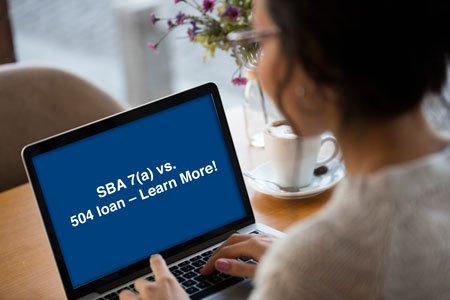Which loans are Right for our Small Business?
Small Business Administration loans are one of the most sought-after financing options for small business owners. SBA loans provide benefits to borrowers and lenders. Small businesses can take advantage of competitive rates and favorable terms, while intermediate lenders can lend with confidence through these government-backed programs. Because these loans are guaranteed by the government, lenders are less risky, opening up more opportunities for small business owners who might not qualify for traditional loans.
That’s why the process of selecting an SBA 504 Loans that can be confusing for small any business owners. These loans are not ‘one size fits all and there are different programs to choose from, each with its own terms, rates, and requirements. The two most popular loans offered by the SBA are 504 loans and 7(a) loans. Business owners unfamiliar with SBA loans may not know which loan to choose, so it’s important to break down the differences in order to make the right financial decisions.
SBA 504 VS 7(a) Loans: Purpose of the Loan
The SBA 504 plan has very specific guidelines on how to use the loan proceeds. The program funds capital assets used to expand or renew small businesses. This includes purchasing long-term commercial real estate, land, and machinery. Land improvements, such as leveling and landscaping, can also be funded, as well as commercial building renovations or construction of new buildings. Proceeds from an SBA 504 loan can also be used to refinance past debt related to the renovation or construction of new facilities.
SBA 7(a) loans are more flexible in terms of product usage. These types of loans can be used for almost all kinds of business expense. 7(a) Loans can be used to purchase equipment, accessories, and inventory. It can be used to refinance existing debt or as working capital for a business. 7(a) loans can also be used to purchase real estate or land or to renovate existing buildings and land, such as 504 loans.
SBA 504 Requirements
To qualify for an SBA 7A Loans, and 504 loan borrowers must find an SBA-approved, certified development company to finance 40% of the project. Another lender, such as a bank or credit union, must provide 50% of the project cost. The borrower will be responsible for paying the remaining 10%.
504 loan borrowers must own a small business in accordance with SBA size criteria. The SBA limits the number of employees you can qualify as a small business. The numbers vary by industry, but the group created an easy-to-use tool for sizing criteria to determine whether a business is eligible for loans and other resources. The business must also have a net worth of less than $15 million and an average net income of less than $5 million for the previous two years.
To qualify for an SBA 504 loan, the business must be for-profit. Businesses engaged in passive, speculative, or not-for-profit activities are excluded from 504 plan funding. All eligible small businesses must be located in the United States.
Although there is no minimum credit score to qualify for an SBA 504 loan, a good score increases a business owner’s chances of getting approved. A score of 680 is generally recommended, but not required. Credit reports must be clear about previous bankruptcy, foreclosures, and defaults on government-guaranteed loans.
Applicants to the 504 loan program are required to submit documents with their applications. This includes, but is not limited to, personal financial statements, federal income tax returns, balance sheets, and income tax returns. Cost documents, including contractor estimates and real estate purchase contracts, also need to be submitted with the application. New businesses operating for less than 2 years will be required to submit a cash flow analysis.
Applicants will be required to submit an Expression of Interest from their lender stating that they will provide 50% of the project cost. The lender must also explain why it will not fund the total cost of the project. All existing or refinanced buildings purchased with proceeds from a 504 loan must be at least 51% owner-occupied. If the building is under construction, it must be at least 60% owner-occupied when the loan is received, increasing to 80% in year 10.

